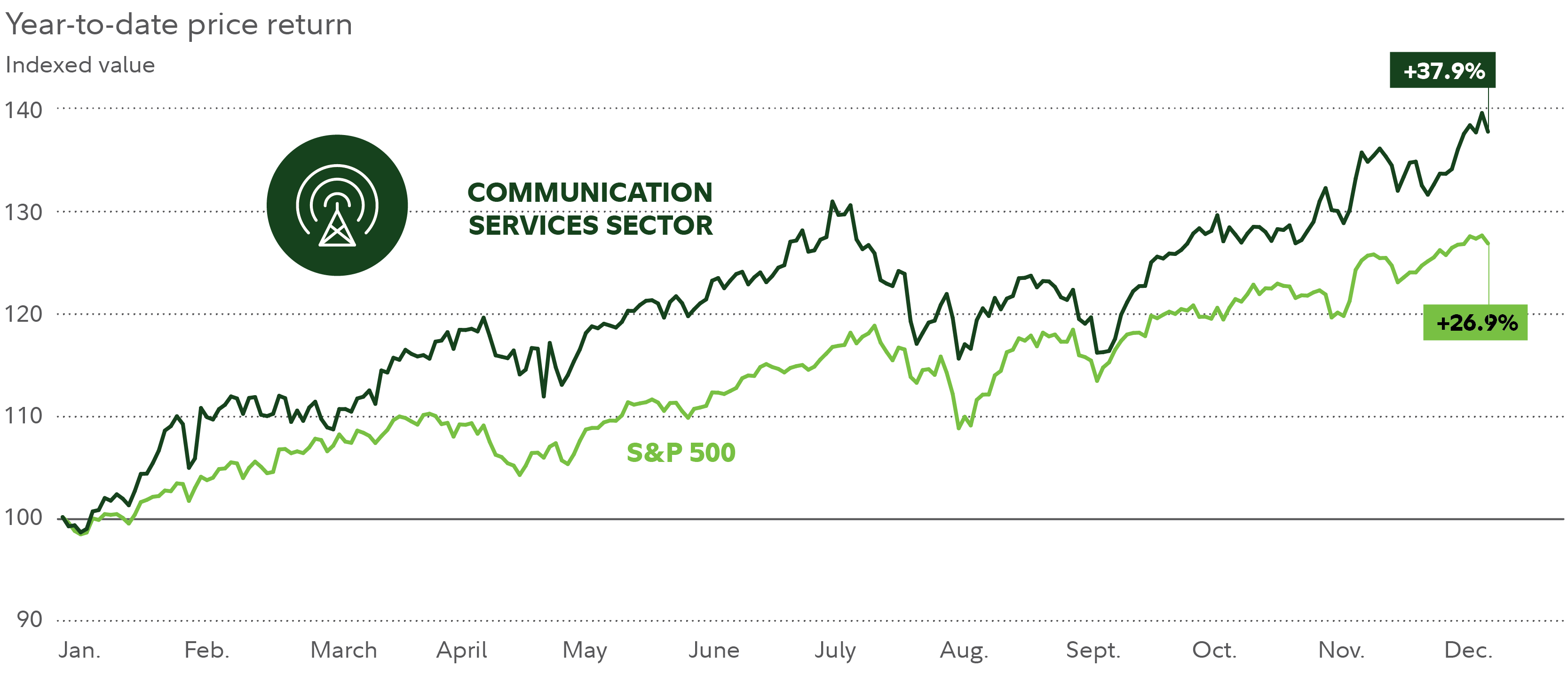Communication services was one of the top-performing sectors in 2024—its second straight year of strong outperformance as investors continued to reward mega-cap tech-related companies and potential beneficiaries of artificial intelligence (AI).
I feel cautiously optimistic about the sector’s outlook for 2025.
Over the near term, digital advertising revenue—which is the lifeblood of sector heavyweights like Meta Platforms (
Over the longer term, the sector looks to be competitively positioned as one of the key beneficiaries of AI advancements and adoption.
2024: A second straight year of banner performance
Communication services offers a diverse array of companies, ranging from more economically sensitive businesses, such as digital and traditional advertising, to areas that are less so, including wireless and broadband service providers. The past year showed the advantages of this diversity, as different parts of the sector led and lagged at different times.
For the first half of 2024, the communication services sector was among the strongest-performing sectors in the S&P 500® index, behind only information technology, as market leadership remained concentrated among the “Magnificent 7.” In addition to benefitting from investor enthusiasm over AI, companies in the interactive media and services subindustry (which includes Meta and Alphabet) also benefitted from improving fundamentals. Cost-cutting efforts helped fuel positive earnings revisions, while strong consumer spending helped drive steady growth in revenue from digital advertising.

In the second half of the year, market volatility increased and the growth-oriented leaders from the first half of the year pulled back. Yet this provided an environment for some of the sector’s more defensive constituents to shine. Wireless and broadband-service providers AT&T Inc. (
Fund top holdings4
Top-10 holdings of the Fidelity® Select Communication Services Portfolio (
- 25.4% – Alphabet Inc. (
- 24.2% – Meta Platforms Inc. (
- 4.9% – The Walt Disney Company (
- 4.9% – AT&T Inc. (
- 4.7% – Netflix Inc. (
- 2.8% – Liberty Broadband Corp. (
- 2.4% – Comcast Corp. (
- 2.3% – Liberty Media Corp. (
- 2.1% – Roblox Corp. (
- 2.0% – Uber Technologies Inc. (
(See the most recent fund information.)
2025: The next chapter in AI adoption
As I look to 2025 and beyond, the most powerful driver of growth within the communication services sector is likely to be AI—particularly for the sector’s 2 largest companies, Meta Platforms and Alphabet, which have also been leaders in AI spending and innovation. The companies have been using AI in 2 primary ways: to enhance their existing businesses and to create new avenues of business, both of which may help boost revenue over the long term.
Digital advertising illustrates how AI has been helping them bolster existing lines of business. AI can help the companies hyper-personalize recommendations for products, services, and content (based on a user’s search, purchase, and viewing history). With better recommendations, Meta and Alphabet have been able to drive online engagement growth and prompt these consumers to take action—leading to improved efficiency and incredible value in connecting businesses with consumers. Looking ahead, generative AI could further enhance the value proposition of advertising products by automating content generation and improving personalization of advertising creative which could increase the activity of advertisers.
Meanwhile, the companies have been exploring potential new lines of business that build on generative AI—in which AI generates new content in response to user prompts. For example, in 2024, Alphabet introduced a new AI-driven feature in Google NotebookLM, its online research and note-taking tool, that can generate an audio podcast featuring virtual hosts that discuss and summarize research. As for Meta, the company recently released its newest version of AI-powered Ray-Ban® smart glasses that feature numerous novel capabilities, from making calls, to live language translation, to “remembering” information like where a user parked their car. These examples may be simply the beginning of a wave of innovation in AI that could drive growth of the technology itself, as well as revenues for the innovators.
To be sure, there are also risks to this outlook. While these established companies appear positioned as today’s AI frontrunners, disruptors have also emerged that could impact competition and innovation across the sector, such as ChatGPT-developer OpenAI. I will be closely monitoring these competitors as they move forward with plans to roll out ad-supported business models in the coming months and years.
Another risk may come from government policy. Although the incoming administration may place less regulatory and antitrust pressure on the sector, technology regulation has been a bipartisan issue. I am closely monitoring how the new administration approaches the sector’s largest companies, especially around issues such as user privacy and free speech.
An exciting time for a dynamic sector
Until this point, many of the winners in AI’s development have been the companies supplying the components to build this technology’s infrastructure, namely the semiconductor makers. However, in this next phase that is just starting, the biggest beneficiaries of AI may be the companies that “own” the consumer. From my vantage point, this has been the distinct advantage of Meta and Alphabet. Their large consumer footprints and deep resources of cash flows, brain power, and computing power may allow them to expand their leadership in the next phase of AI.
In all, I view this as an exciting time to invest in the sector and am looking forward to how AI may transform companies in 2025 and beyond.

Priyanshu Bakshi is a sector leader and portfolio manager in the Equity division at Fidelity Investments. Fidelity Investments is a leading provider of investment management, retirement planning, portfolio guidance, brokerage, benefits outsourcing, and other financial products and services to institutions, financial intermediaries, and individuals.
In this role, Mr. Bakshi is the co-sector leader of the global technology team. He covers internet platform stocks as well as Asia-Pacific mega-cap semiconductor and internet stocks. He co-manages Fidelity Select Communication Services Portfolio, Fidelity Advisor Communications Services Fund, and Fidelity VIP Communication Services Portfolio.* He is a member of Fidelity's Stock Selector Large Cap Group and is also responsible for managing the information technology and communication services sleeves for various diversified sector-based portfolios.*
Prior to joining Fidelity in 2015, Mr. Bakshi was a senior investment analyst at New Vernon Capital where he covered stocks in the small and mid cap space of emerging markets. He was also an assistant manager at Jones Lang LaSalle where his responsibilities included investment banking focused on the real estate sector. He has been in the financial industry since 2007.
Mr. Bakshi earned his bachelor of business studies in finance from the University of Delhi and his master of business administration in analytic finance and economics from the University of Chicago. He is also a CFA® charterholder.
* Effective July 26, 2024, Priyanshu Bakshi is a co-manager of Fidelity Select Communication Services Portfolio, Fidelity Advisor Communication Services Fund and Fidelity VIP Communication Services Portfolio as well as the communication services sleeves of the Fidelity Advisor Balanced Fund, Fidelity Balanced Fund, VIP Balanced Portfolio, and VIP Stock Selector All Cap Portfolio until January 1, 2025, at which time he will become the sole portfolio manager.



